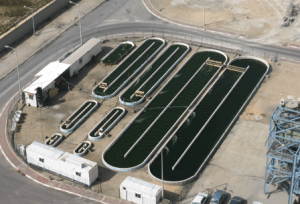By: Dr. John Kyndt ( Head Scientist of the Renewable Energy Program at Advanced Energy Creations Lab) and Dr. Aecio D’Silva

We have advocated growing algae for biofuels production as the primary goal on several occasions. Current research in many parts of the world is being focused on making this process more economical.
The question our group is raising is what if we could obtain large amounts of algae biomass as a byproduct from another process? That would significantly reduce the production cost. This might not be such a farfetched idea.
Using algaeforbiofuels from wastewater treatment is gaining a lot of interest lately. This process is also referred to as ‘phycoremediation’. There are several approaches being developed, but they all offer some interesting advantages over conventional wastewater treatment processes.
1. Low energy requirements
Photosynthetically grown algae in open ponds are low in energy input needs
2. Reduction in sludge formation
Conventional treatments require hazardous chemicals and generate hazardous waste sludge that needs to be disposed off in landfills. Phycoremediation eliminates the need for environmentally unfriendly chemicals.
3. Less greenhouse gas production
Conventional treatment plants produce large amounts of greenhouse gasses. The advantage of using algae is that they are expected to consume more CO2 than is released in the process.
4. Cost effectiveness
Due to the low energy cost, lower operation costs and potential use of algae biomass, some have predicted that phycoremediation is significantly more cost effective than conventional processes. High operation costs make waste water treatment conventionally unviable in many countries.
5. Produce useful algal biomass
The biomass is useful for the production of biodiesel or bioethanol through processes that we have described in our other blogs. As we have shown, there are promising advantages of using algae for these types of fuels and now is an excellent time to invest in this opportunity.
Waste water is typically performed in a three step process: primary, secondary and tertiary stages. Algae can in theory be used in each step, but the main focus of research and testing occurs at the secondary stage.
Both municipal and industrial water effluent could be used for algae growth. Although the composition of different waste water types will differ widely, the algae will purify the water by assimilating nitrates and phosphates and CO2 fixation. The primary and pretreatment steps will have to be optimized for each different industry. We are currently adapting and optimizing novel algae strains to grow to high yields on some of these types of waste water.
Three types of wastewater treatment systems are typically being used for algae based treatment:
-Waste Stabilization Pond Systems (WSPs): open ponds where algae grow photosynthetically, generate O2, which is used by bacteria that break down the organic compounds in the water. The latter generates CO2, which is captured and fixed by the algae during photosynthetic growth.
-High Rate Algal ponds (HRAP): shallow, paddle wheel mixed open raceway ponds. Faster growth rate than traditional WSP’s.
-Photobioreactors (PBRs): Closed systems. Higher capex and operation cost, but more algae biomass per liter generated.
Each of these is different in its economical viability, stage of development and speed. WSPs are typically the least expensive, but HRAP systems have more efficient assimilation of wastewater nutrients into algal biomass. PBRs are considered not to be economically viable and so far haven’t been scaled up for phycoremediation.
Interestingly, similar challenges need to be overcome in phycoremediation as in current algae for biofuel development. Treatment and processes need to be optimized, harvesting systems need to be cost effective and byproducts need to be exploited to make the process viable. Besides optimizing the algae growth (water depth, nutrient addition rate, mixing, etc) the water treatment also needs to be optimized (reduce BOD and TDS, remove nitrate and phosphate at optimal rate, etc.).
Nevertheless, growing algae on these waste streams appears to be a win-win situation. In the end, the water comes out purified and energy-rich biomass is created. A true energy-water nexus!
Member of American Aquabiotech, Biofuels Revolution, Moura Enterprises and MyBeloJardim (ver. Portuguese) Profs. Aecio D’Silva, Dr. John Kyndt and MSc. Fabiano Moura’s Group



Aloha Dr.’s Kyent and D’Silva, and thanks for a great article. Here in Hawaii, especially Oahu, we have an acute problem with excess waste water and sludge. We are also in dire need of renewable energy as 90% of our current usage comes from imported oil. It would seem that to merge the two would be ideal. Can you recommend any companies that might be interested in exploring the viability of such a project here?
Thanks so much,
John Floyd
[…] Algae For Waste Water Treatment And BioFuel Production: A Double Winner […]
Algae is a very cost effective and efficient way to produce algae biofuel. It emits less carbon dioxide thats leads to less pollution.
[…] we posted before, depending on the wastewater source, there may also be a need for an alternative primary cleanup step, which will need to feed into the […]
hello, its a great article indeed. But i would like to know how much algae is required for the treatment of 100 or 1000 gallon of waste water or how much waste water can be cleaned by 1 ton of algae? hoping for a quick answer…. thank tou
I am new to this whole way of thinking and I am full questions some will be good and some may seem like I should have know that. So on to those questions I have is how much algae is needed to produce a usable quanity of fuel? How soon once the algae is harvested do you need to transfer it to a place where you can make a new batch of fuel?